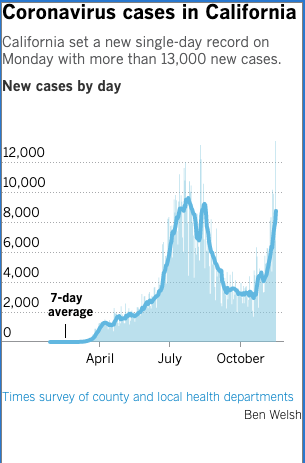California officials on Monday pulled what they characterized as an emergency brake, announcing a dramatic rollback of reopening in much of the state as it broke its single-day record for new coronavirus cases.
Once the changes go into effect Tuesday, 94% of Californians — roughly 37 million people — will live in counties that are in the strictest tier of the state’s reopening roadmap. Many businesses in those counties will have to suspend or severely limit their indoor operations.
The move came as California recorded 13,412 new cases Monday, according to The Times’ coronavirus tracker. That is the highest daily total since the pandemic began and a sign of how quickly the coronavirus is spreading.
“We are seeing community spread broadly now throughout the state of California,” Gov. Gavin Newsom said.
Last week, just 13 of California’s 58 counties were in the strictest tier, purple, indicating widespread transmission of the disease. Newsom announced Monday that the number would more than triple, to 41.
Among the counties that have newly fallen back into the purple tier are Orange, Ventura, Santa Barbara, Kern and San Luis Obispo. Los Angeles, San Bernardino, Riverside, San Diego and Imperial counties were already in that category.
The most populated counties in the Bay Area were also sent back to the purple tier, including Santa Clara, Alameda, Contra Costa, Napa and Solano. All eight counties in the San Joaquin Valley are now in the purple tier.
The purple swath also covers all of California’s Central Coast and much of the area in and around Sacramento County.
Among counties in the purple tier, California officials require that the following types of indoor settings be closed to the public: restaurant dining rooms, gyms, dance and yoga studios, movie theaters, museums, zoos and aquariums. Houses of worship can no longer hold in-person services indoors, and most retail stores, indoor malls and libraries can only open to 25% capacity; grocery stores are allowed to open to 50% capacity.
Monday’s announcement comes amid the steepest rise in coronavirus cases that California has seen. Over the seven-day period that ended Sunday, the state averaged 7,985 cases per day, a rate that has nearly doubled in the past two weeks, according to data compiled by The Times.
The rolling metric hasn’t been that high since mid-August, and it is a far cry from just a month ago, when the seven-day average of new cases dipped below 3,000.
“This is simply the fastest increase California has seen since the beginning of this pandemic,” Newsom said.
Los Angeles County reported more than 3,000 new infections on both Saturday and Sunday; the 3,780 cases on Saturday represented the highest one-day total since mid-July.
Even on Monday, when case counts are typically lower because of reporting lags over the weekend, officials announced 2,795 new cases.
“It is clear that L.A. County is at a very dangerous point in the pandemic,” county Public Health Director Barbara Ferrer said.
As the case count swells, officials stress that it’s essential for residents to follow infection prevention protocols: Wear a mask in public, wash hands regularly, stay home when sick and keep a physical distance from, and avoid gathering with, those outside your household.
None of those are novel concepts in the battle against the coronavirus. As Ferrer put it, “This isn’t like we don’t know what to do. This is about getting back to doing what works.”
“As a community and as individuals, we’re going to need to be laser-focused on reducing transmission,” she said during a briefing. “To say many lives are at stake is not an exaggeration.”
Once the changes go into effect, 11 counties will be in the second-most severe, or red, category: Del Norte, Modoc, Humboldt, Plumas, Colusa, Lake, Marin, San Francisco, San Mateo, Amador and Mono.
Four are in the third, orange, tier — Lassen, Sierra, Calaveras and Inyo — and only two, Alpine and Mariposa, remain in the least-restrictive, yellow, tier.
Even more changes could be coming. Although California has typically updated its tier assignments weekly on Tuesdays, Newsom said those determinations would now be made and announced closer to real time.
“We need now to be more aggressive,” he said, “more surgical, more targeted.”
The tier system categorizes counties based on their average daily number of new coronavirus cases for every 100,000 residents and the percentage of conducted tests that detect the virus.
Counties used to regress only if their metrics fell in the range of a more restrictive tier for two straight weeks. Now, those decisions can be made based on one week’s worth of data.
Some counties saw their metrics worsen this week to the point that they slid back multiple categories. Among them was San Francisco, which was long hailed as a coronavirus success story but is now “seeing an explosion of new cases throughout the city,” Public Health Director Grant Colfax said during an online news conference.
The number of those infected with the coronavirus who are ill enough to require hospitalization has also spiked in recent weeks. As of the latest tally, there were 3,852 COVID-19 hospitalizations statewide — up roughly 48% from two weeks ago. There are 1,031 COVID-19 patients in intensive care.
“As I say to my patients often, ‘When I’m worried, I’ll tell you, so you can worry with me.’ And we’re there,” said Dr. Mark Ghaly, California’s Health and Human Services secretary.
Eventually, “about 12% of those cases end up in the hospital,” he said during a briefing Friday, “and when you look at a high number of cases day over day, and that’s sustained, that’s exactly what we worry about in terms of overwhelming our hospital system.”
